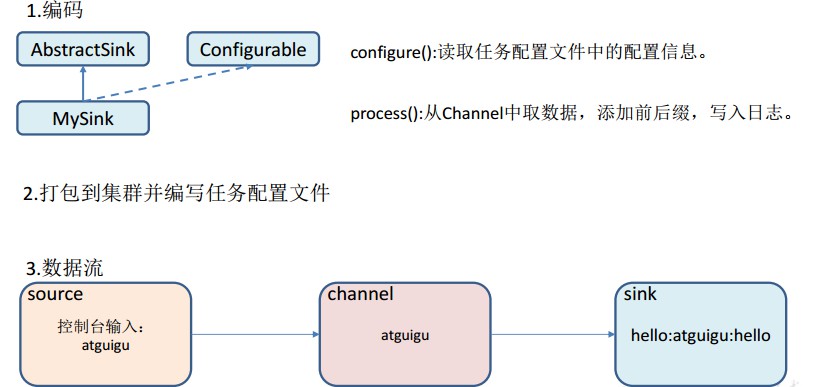大数据学习
bigdata learning
Toggle navigation
大数据学习
主页
openGauss数据库
Flume
MongoDB
Hadoop
数据库实验
Kafka
Zookeeper
Hbase
Manual
Spark
Neo4j
InfluxDB
RabbitMQ
Flink
About Me
归档
标签
12-Flume案例-自定义Sink
Flume
2022-09-27 17:22:20
28
0
0
bigdata
Flume
# Flume案例-自定义Sink Sink不断地轮询Channel中的事件且批量地移除它们,并将这些事件批量写入到存储或索引系统、或者被发送到另一个Flume Agent。 Sink是完全事务性的。在从Channel批量删除数据之前,每个Sink用Channel启动一个事务。批量事件一旦成功写出到存储系统或下一个Flume Agent,Sink就利用Channel提交事务。事务一旦被提交,该Channel从自己的内部缓冲区删除事件。 Sink组件目的地包括hdfs、logger、avro、thrift、ipc、file、null、HBase、solr、自定义。官方提供的Sink类型已经很多,但是有时候并不能满足实际开发当中的需求,此时我们就需要根据实际需求自定义某些Sink。 官方也提供了自定义sink的接口: https://flume.apache.org/FlumeDeveloperGuide.html#sink根据官方说明自定义MySink需要继承AbstractSink类并实现Configurable接口。 实现相应方法: configure(Context context)//初始化context(读取配置文件内容)process()//从Channel读取获取数据(event),这个方法将被循环调用。 使用场景:读取Channel数据写入MySQL或者其他文件系统。 ## 1)案例需求: 使用 flume 接收数据,并在 Sink 端给每条数据添加前缀和后缀,输出到控制台。前后缀可在 flume 任务配置文件中配置。 ## 2)需求分析:  ## 3)实现步骤: ### 1.编写代码 ```java package org.nbubigdata.flume; import org.apache.flume.*; import org.apache.flume.conf.Configurable; import org.apache.flume.sink.AbstractSink; import org.slf4j.Logger; import org.slf4j.LoggerFactory; public class MySink extends AbstractSink implements Configurable { //创建 Logger 对象 private static final Logger LOG = LoggerFactory.getLogger(AbstractSink.class); private String prefix; private String suffix; @Override public Status process() throws EventDeliveryException { //声明返回值状态信息 Status status; //获取当前 Sink 绑定的 Channel Channel ch = getChannel(); //获取事务 Transaction txn = ch.getTransaction(); //声明事件 Event event; //开启事务 txn.begin(); //读取 Channel 中的事件,直到读取到事件结束循环 while (true) { event = ch.take(); if (event != null) { break; } } try { //处理事件(打印) LOG.info(prefix + new String(event.getBody()) + suffix); //事务提交 txn.commit(); status = Status.READY; } catch (Exception e) { //遇到异常,事务回滚 txn.rollback(); status = Status.BACKOFF; } finally { //关闭事务 txn.close(); } return status; } @Override public void configure(Context context) { //读取配置文件内容,有默认值 prefix = context.getString("prefix", "hello:"); //读取配置文件内容,无默认值 suffix = context.getString("suffix"); } } ``` ### 2.测试 将写好的代码打包,并放到 flume 的 lib 目录(/usr/local/flume/lib)下。 配置job/mysink.conf文件: ```bash # Name the components on this agent a1.sources = r1 a1.sinks = k1 a1.channels = c1 # Describe/configure the source a1.sources.r1.type = netcat a1.sources.r1.bind = localhost a1.sources.r1.port = 44444 # Describe the sink a1.sinks.k1.type = org.nbubigdata.flume.MySink #a1.sinks.k1.prefix = nbu: a1.sinks.k1.suffix = :nbu # Use a channel which buffers events in memory a1.channels.c1.type = memory a1.channels.c1.capacity = 1000 a1.channels.c1.transactionCapacity = 100 # Bind the source and sink to the channel a1.sources.r1.channels = c1 a1.sinks.k1.channel = c1 ``` 开启任务: ```bash nbu@ecs:/usr/local/flume$ bin/flume-ng agent -c conf/ -f job/mysink.conf -n a1 -Dflume.root.logger=INFO,console nbu@ecs:~$ nc localhost 44444 hello OK nbu OK ``` 结果展示: 
上一篇:
11-Zookeeper数据同步与Leader选举
下一篇:
12-MongoDB案例-JavaApi实践
文档导航